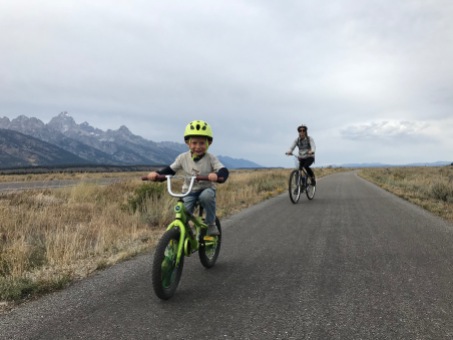After 10 days navigating Yellowstone’s massive roadways and crowds, we ventured south to Grand Teton National Park, which quickly eclipsed our enjoyment of Yellowstone thanks to its smaller size and even smaller crowds. As you enter Grand Teton you notice the immensely flat landscape broken by a single chain of mountains. With no foothills to obscure the view the Tetons are visible from nearly the entire park and provide the most jaw dropping backdrop to everything you see.
As with Yellowstone, many of the campgrounds were closed for the season, so we settled on Gros Ventre at the very southern border of the park. The campground is situated along the Gros Ventre river and is heavily wooded with cottonwoods whose leaves had turned a brilliant shade of yellow, which contrasted perfectly with the never-ending blue sky. In addition to the outstanding scenery of the campground, Gros Ventre is a hot bed for moose activity. We could hear them walking by the camper at night and watched them grazing in the mornings and evenings.
Nearby was Mormon row which we explored one evening near sunset. This area includes several old structures left over from some of the earliest settlers to the area. It includes an old barn that is in nearly every picture you see of Grand Teton. We had fun poking around the old farmsteads imagining what life was like, the back-breaking labor probably didn’t seem quite so hard when you had that fantastic view to look at all day.
One of the things we liked most about Grand Teton was the variety of activities we could enjoy. There is plenty of hiking to be had, but there are also several bodies of water and a bike trail that travels from the park all the way into Jackson Hole. We managed to put the canoe in twice, once on the Snake River where we observed four bald eagles flying over us – 2 of which were squawking up a storm as they swooped and circled, playing in the sky. The river was pristine and at times we would look down and see nothing but fish blanketing the bottom. On another paddle we canoed across Jenny Lake before hiking to a waterfall on the other side. Shortly after leaving the boat we ran into a young black bear on the trail, which was quite a treat.
Our last day we hopped on our bikes for an 8-mile ride to the National Museum of Wildlife Art located just a few miles outside the park. While the family was skeptical at my suggestion to visit an art museum, they were all quickly smitten. The museum hosts artwork from the 1500s to present day, all with the common thread of wildlife. Many of the subjects were from the western parks we had been visiting and the historical descriptions given next to each of them added a layer to our appreciation of the American West. My favorite artist by far was Carl Rungius, an impressionist who completed some of his most popular work in the early 1900s and became one of America’s most notable wildlife artists. For as much as Rick and I enjoyed wandering through the galleries, Liam and Cora Jean had a ball in the children’s wing. It was full of books, puzzles, dress up clothes all related to animals. And the crowning jewel was the art studio where the kids could work with clay, paint, or sketch their own wildlife art. The studio even had animal models from bird beaks and feet, to various mammal noses and eyeballs!
The trip wouldn’t be complete without Rick sneaking off to tackle one of the more difficult hikes in the park, which for the Tetons was Amphitheater Lake. The hike offers views of Grand Teton from a beautiful sub-alpine lake located at 10,000 ft…or so I’m told. ☹



















